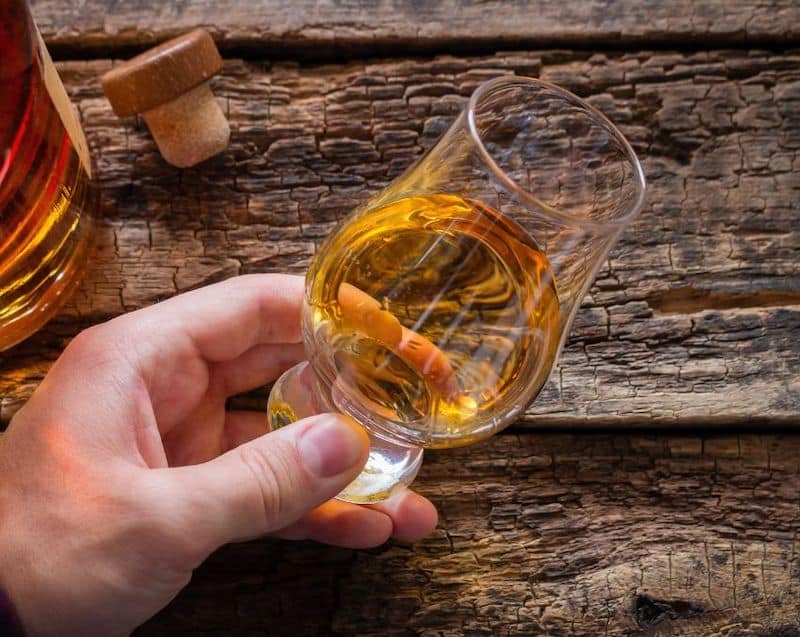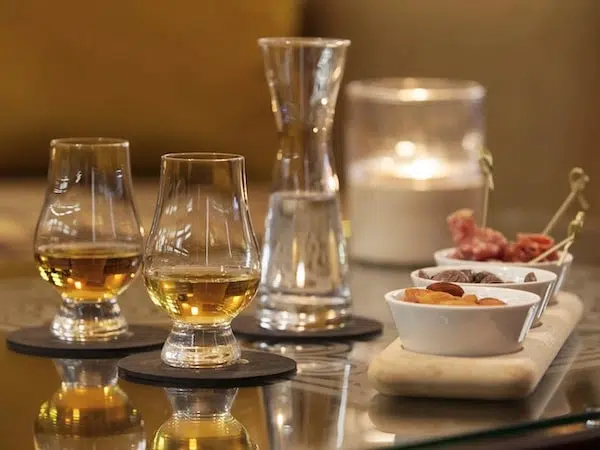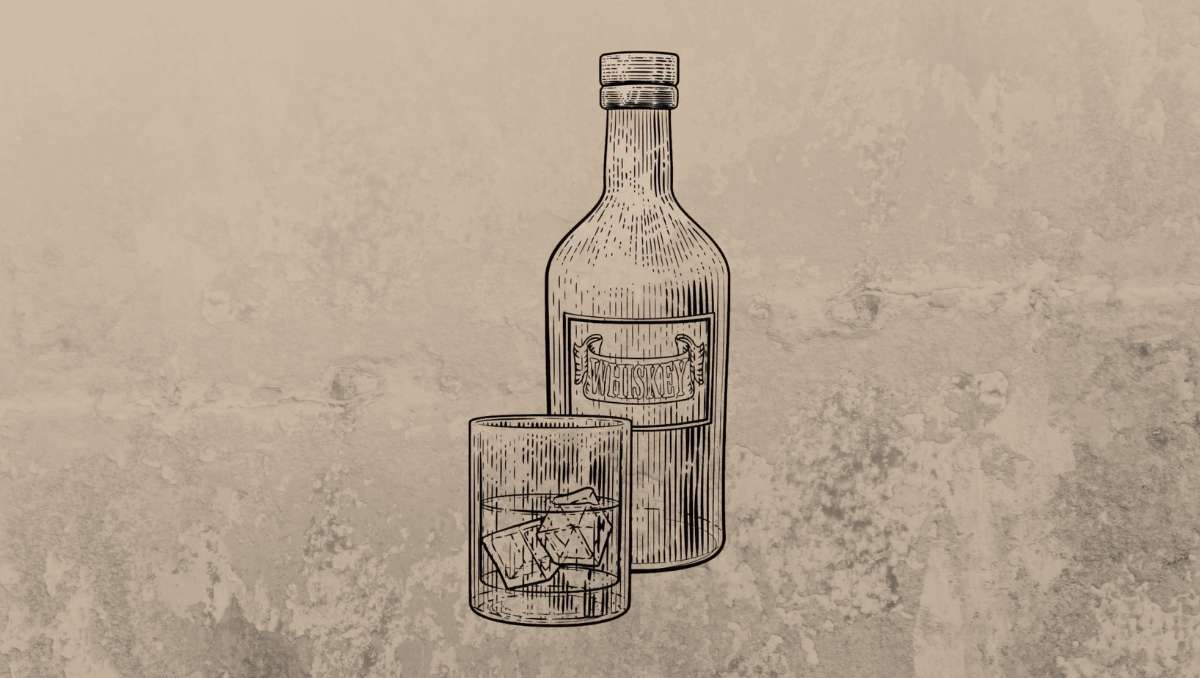Whiskey is one of the most popular spirits in the world. The barrel-aged beverage is a favorite in Europe, Northern America, and Asia, and our Whiskey 101 gives you some great insights.
If you're new to Whiskey, there are many questions. What does Single Malt mean? What is the difference between Bourbon and whiskey? Or also, what is the difference between a whisky and a whiskey? What is meant by "a dram"? The list goes on.
Our whiskey guide will provide all the answers and more.
Whiskey Fact Sheet
- Spirit base: Grains like barley, corn, rye, or wheat
- ABV: 40% to 68.5%
- Proof: 80 to 137
- Calories per ounce: 68 to 120
- Origin: Ireland
- Color: Golden brown (depends on the time of aging, wood, etc.)
- Best served: Neat or in cocktails

What is Whiskey?
Simply put, whiskey is an amber-colored, distilled spirit made from malted grains like barley, corn, rye, and wheat. The composition of the grains in a product, known as mash bill, varies between the different styles as do the distillation methods.
After distillation, whiskey is aged in barrels for at least two years up to a few decades. The longer it matures, the higher the quality of the spirit.
The different Whiskey types
Whiskey is usually categorized by origin, and the most popular types are:
- Scotch Whisky (Scotland)
- Irish Whiskey
- Canadian Whisky
- Japanese Whisky
- Bourbon and Rye (United States)
Before we go a little more into detail, I first want to quickly answer a question: what is the difference between the two spellings whiskey and whisky?
Both words refer to the same thing and first and foremost indicate the origin of a product: While Ireland and the US use the term Whiskey for their aged grain liquor, other important producers like Scotland, Canada, and Japan write Whisky without an e.
The history behind the different spellings goes back hundreds of years to a rivalry between Ireland and Scotland. If you are interested, here is the entire story. But a brief guide to the different types:
Scotch Whisky
Scotch Whisky has to be produced in Scotland and must contain barley. Most Scotch is distilled in one of the five official Scotch regions: Campbelltown, Highlands, Lowlands, Speyside, or Islay.
This type needs to age a minimum of three years in wooden barrels. Usually, the distilleries use former Bourbon or Sherry barrels. Sometimes they also use new casks. Scotch has five different sub-types:
- Single Malt: Single Malt Scotch is produced using malted barley only and distilled at one single distillery. It is considered the highest quality.
- Single Grain: Single grain is also produced in one distillery. But in addition to malted barley, other grains are used too.
- Blended Malt: This type is made by blending Single Malt Whiskies from different distilleries.
- Blended Grain: a blend of Single Grains from more than one distillery.
- Blended: the most common type of Scotch. Blended Scotch is a combination of Single Malts and Single Grains.
For more details, read our guide to Scotch.

Irish Whiskey
The main ingredients in Irish Whiskey are malt and barley. To be called Irish Whiskey, the liquor must be produced on the green isle and has to age for at least three years in wooden barrels. Most of them are triple-distilled, though this is not a must.
Overall, Ireland's laws regarding Whiskey are far less strict than Scotland's. But still, there are two sub-types that you should know.
- Single Pot Still: This Irish Whiskey is made at a single distillery from a mix of malted and unmalted barley, distilled using a pot still.
- Blended Irish: The standard type of Irish Whiskey. When producers combine separately distilled Whiskeys into one product, they have to put "blended" on the bottle label.
Canadian Whisky
Canadian Whisky is made with rye and corn. It has to barrel-age for at least three years to be called Whisky.
It's often labeled as Rye Whisky. However, that doesn't mean that it's 100% rye. In fact, oddly, Canadian Whisky can be labeled as rye when not containing any rye at all.
The reason is historical: Canada was once known for producing high-quality Rye Whiskey, but they never protected the term legally. The name stuck, and producers kept using it even when not working with rye.
Japanese Whisky
Japanese Whisky is up and coming. Based on the traditional Whisky producing methods from Scotland that Masataka Taketsuru, a chemist and businessman, brought to Japan in the 1920s, Japanese Whiskey has developed its own unique style.
This close connection to Scotch is why Japan produces Single Malt whisky. Nevertheless, Japanese and Scotch Whisky are far from the same: Scotch is quite famous for its smoky flavor, and Japanese whisky is known to be light and nuanced.
American
American whiskey is usually either Bourbon or Rye:
- Bourbon: known for its sweet taste. To be classified as a Bourbon, the spirit has to contain at least 51% of corn and age in freshly charred oak barrels for at least two years. The vast majority of Bourbon is from Kentucky but it can be distilled anywhere in the US. Read our guide to Bourbon to learn more.
- Rye: this type needs to contain at least 51% of rye. Like Bourbon, Rye Whiskey needs to mature for a minimum of two years in newly charred oak barrels.
Rye and Bourbon are quite different in taste. While Bourbon is rather sweet, Rye is known to be way spicier. But let's take a closer look at the taste of whiskey in general.
The taste of Whiskey
The taste of whiskey strongly differs from type to type. Yet, because all types mature in wooden barrels, they all have oaky notes and a hint of vanilla.
Bourbon is known for its sweet corn taste and usually also shows notes of caramel. Scotch, on the other hand, is known for its peaty flavors. Irish Whiskey is light and often has subtle fruity notes, while Rye has a more spicy touch, and Japanese Whisky has smooth and mild flavors.
How to drink Whiskey
Like all aged spirits, whiskey is best consumed neat in a tumbler or other types of whiskey glasses. This way, you can smell all the aromas and taste the different flavors. The standard serving of whiskey is called a dram. However, the size of a dram depends on who you ask.
Between your sips, you should cleanse your palate. The easiest way to do this is by sipping a bit of water.
If you're tasting a strong Whiskey, adding a few drops of water to it can actually help detect flavors as it opens them up. But start slowly and don't add too much at once.
Whiskey in Cocktails

Whiskey is also great in mixed drinks and cocktails. Many of the most popular classic cocktail recipes call for Whiskey: Whiskey Sour, Old Fashioned, Manhattan, or the Mint Julep, to name only a few - for a more exhaustive list, check out our favorite 23 whiskey cocktails.
Since whiskey varies notably in taste, finding the right one for your drink can be challenging. Hence, here are some of our recommendations:
- Best Whiskey for Old Fashioned cocktails (all types)
- Best Rye for making an Old Fashioned
- Best Whiskies for Whiskey Sour
History
The history of whiskey started a long time ago. However, it's unclear whether Ireland or Scotland created the first version of the grain spirit. Both declare to be inventors, but many of these claims lack proof.
Yet, we do know the term Whiskey originates from the Gaelic word Uisge. It is the short form of uisge beatha, better known today as Aqua Vitae (water of life). We also know that the craft of distilling spirits from low-alcohol liquids came to Ireland and Scotland between 1100 and 1300.
Traditionally, Aqua Vitae is made by distilling wine. But because neither Scotland nor Ireland was famous for their vineyards, local monks had to ferment something else.
In 1494, a monk called John Cor produced the first barley-based Aqua Vitae documented in writing. He distilled the spirit in Lindores Abbey, located in the Scottish council of Fife. [1].
His whiskey was clear, unaged, and flavored with various herbs and plants. -Very much different from what we now know as whiskey.
The oldest licensed distillery to produce whiskey is in Ireland. Bushmills -still operating today- got their royal license to distill whiskey in 1608.
Early settlers in America from Ireland and Scotland brought the methods to produce whiskey with them. But, as barley was hard to ferment, they started experimenting with rye, wheat, and eventually corn.
Whiskey today
The method of barrel-aging whiskey, as we know it today, was invented only in the 18th century by the Scots. They accidentally discovered that transporting their whiskey in barrels improved its taste.
Japanese Whiskey production started in the 1920s after pioneer Masataka Taketsuru visited Scotland to learn the craft and technique. He brought his knowledge and Scotch pot stills back to Japan, where he founded the first Japanese distilleries in 1934.
-The company behind these two distilleries, Nikka, is a leading brand in Japan and the world.
How to make Whiskey
Making whiskey includes many different procedures, which we can group into the following essential steps:
- Malting
- Mixing the mash bill
- Cooling
- Fermenting
- Distilling
- Aging
- Bottling
In short, the first three steps prepare the ingredients for fermentation, then convert the sugars into alcohol to create a low-ABV liquid.
That liquid is distilled once or multiple times before it ages in wooden barrels. After barrel-aging, the spirit is either bottled directly or blended and then bottled.

